ESP JEEP WRANGLER UNLIMITED 2020 Owner handbook (in English)
[x] Cancel search | Manufacturer: JEEP, Model Year: 2020, Model line: WRANGLER UNLIMITED, Model: JEEP WRANGLER UNLIMITED 2020Pages: 330, PDF Size: 9.16 MB
Page 212 of 330
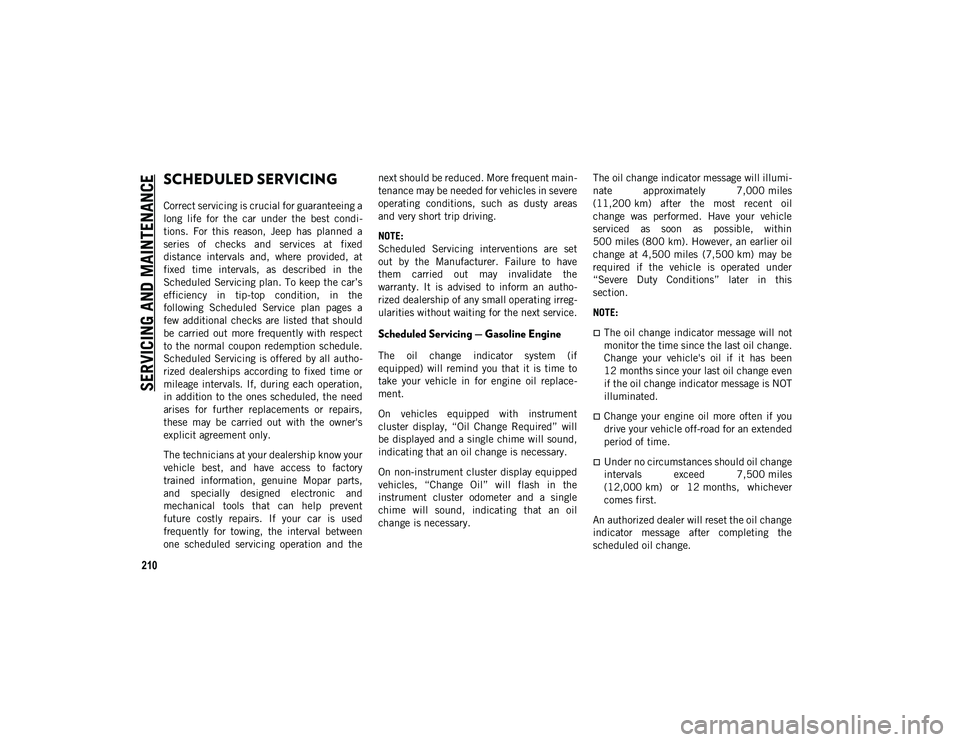
210
SERVICING AND MAINTENANCE
SCHEDULED SERVICING
Correct servicing is crucial for guaranteeing a
long life for the car under the best condi-
tions. For this reason, Jeep has planned a
series of checks and services at fixed
distance intervals and, where provided, at
fixed time intervals, as described in the
Scheduled Servicing plan. To keep the car’s
efficiency in tip-top condition, in the
following Scheduled Service plan pages a
few additional checks are listed that should
be carried out more frequently with respect
to the normal coupon redemption schedule.
Scheduled Servicing is offered by all autho -
rized dealerships according to fixed time or
mileage intervals. If, during each operation,
in addition to the ones scheduled, the need
arises for further replacements or repairs,
these may be carried out with the owner's
explicit agreement only.
The technicians at your dealership know your
vehicle best, and have access to factory
trained information, genuine Mopar parts,
and specially designed electronic and
mechanical tools that can help prevent
future costly repairs. If your car is used
frequently for towing, the interval between
one scheduled servicing operation and the next should be reduced. More frequent main
-
tenance may be needed for vehicles in severe
operating conditions, such as dusty areas
and very short trip driving.
NOTE:
Scheduled Servicing interventions are set
out by the Manufacturer. Failure to have
them carried out may invalidate the
warranty. It is advised to inform an autho -
rized dealership of any small operating irreg -
ularities without waiting for the next service.
Scheduled Servicing — Gasoline Engine
The oil change indicator system (if
equipped) will remind you that it is time to
take your vehicle in for engine oil replace -
ment.
On vehicles equipped with instrument
cluster display, “Oil Change Required” will
be displayed and a single chime will sound,
indicating that an oil change is necessary.
On non-instrument cluster display equipped
vehicles, “Change Oil” will flash in the
instrument cluster odometer and a single
chime will sound, indicating that an oil
change is necessary. The oil change indicator message will illumi
-
nate approximately 7,000 miles
(11,200 km) after the most recent oil
change was performed. Have your vehicle
serviced as soon as possible, within
500 miles (800 km). However, an earlier oil
change at 4,500 miles (7,500 km) may be
required if the vehicle is operated under
“Severe Duty Conditions” later in this
section.
NOTE:
The oil change indicator message will not
monitor the time since the last oil change.
Change your vehicle's oil if it has been
12 months since your last oil change even
if the oil change indicator message is NOT
illuminated.
Change your engine oil more often if you
drive your vehicle off-road for an extended
period of time.
Under no circumstances should oil change
intervals exceed 7,500 miles
(12,000 km) or 12 months, whichever
comes first.
An authorized dealer will reset the oil change
indicator message after completing the
scheduled oil change.
2020_JEEP_JL_WRANGLER_UG_RHD_UK.book Page 210
Page 234 of 330
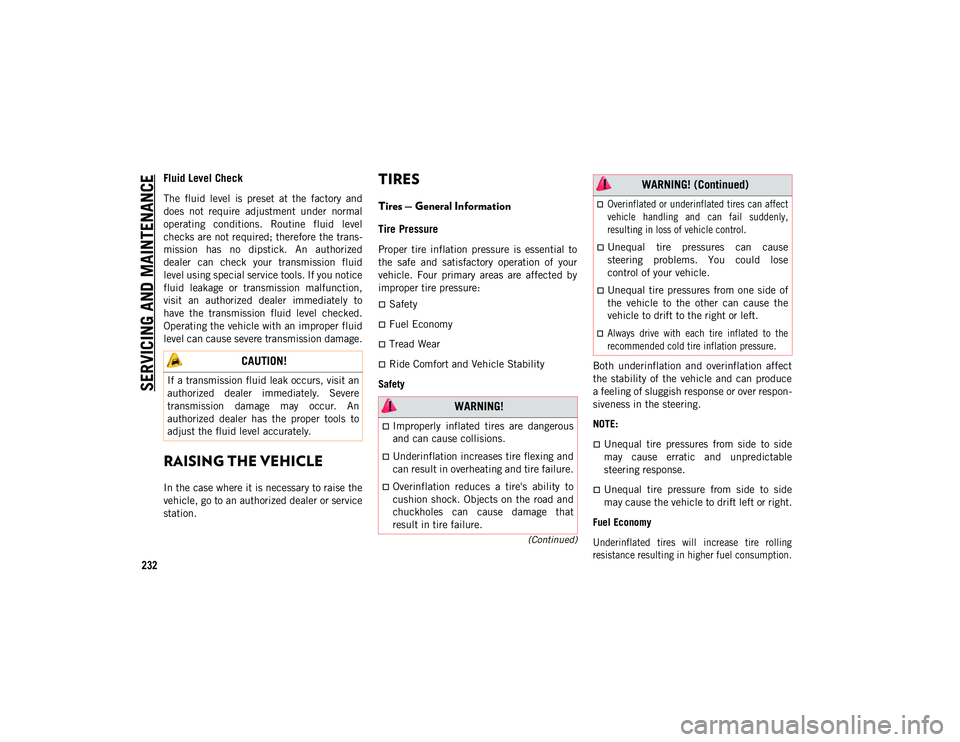
SERVICING AND MAINTENANCE
232
(Continued)
Fluid Level Check
The fluid level is preset at the factory and
does not require adjustment under normal
operating conditions. Routine fluid level
checks are not required; therefore the trans-
mission has no dipstick. An authorized
dealer can check your transmission fluid
level using special service tools. If you notice
fluid leakage or transmission malfunction,
visit an authorized dealer immediately to
have the transmission fluid level checked.
Operating the vehicle with an improper fluid
level can cause severe transmission damage.
RAISING THE VEHICLE
In the case where it is necessary to raise the
vehicle, go to an authorized dealer or service
station.
TIRES
Tires — General Information
Tire Pressure
Proper tire inflation pressure is essential to
the safe and satisfactory operation of your
vehicle. Four primary areas are affected by
improper tire pressure:
Safety
Fuel Economy
Tread Wear
Ride Comfort and Vehicle Stability
Safety Both underinflation and overinflation affect
the stability of the vehicle and can produce
a feeling of sluggish response or over respon
-
siveness in the steering.
NOTE:
Unequal tire pressures from side to side
may cause erratic and unpredictable
steering response.
Unequal tire pressure from side to side
may cause the vehicle to drift left or right.
Fuel Economy
Underinflated tires will increase tire rolling
resistance resulting in higher fuel consumption.
CAUTION!
If a transmission fluid leak occurs, visit an
authorized dealer immediately. Severe
transmission damage may occur. An
authorized dealer has the proper tools to
adjust the fluid level accurately.
WARNING!
Improperly inflated tires are dangerous
and can cause collisions.
Underinflation increases tire flexing and
can result in overheating and tire failure.
Overinflation reduces a tire's ability to
cushion shock. Objects on the road and
chuckholes can cause damage that
result in tire failure.
Overinflated or underinflated tires can affect
vehicle handling and can fail suddenly,
resulting in loss of vehicle control.
Unequal tire pressures can cause
steering problems. You could lose
control of your vehicle.
Unequal tire pressures from one side of
the vehicle to the other can cause the
vehicle to drift to the right or left.
Always drive with each tire inflated to the
recommended cold tire inflation pressure.
WARNING! (Continued)
2020_JEEP_JL_WRANGLER_UG_RHD_UK.book Page 232
Page 235 of 330
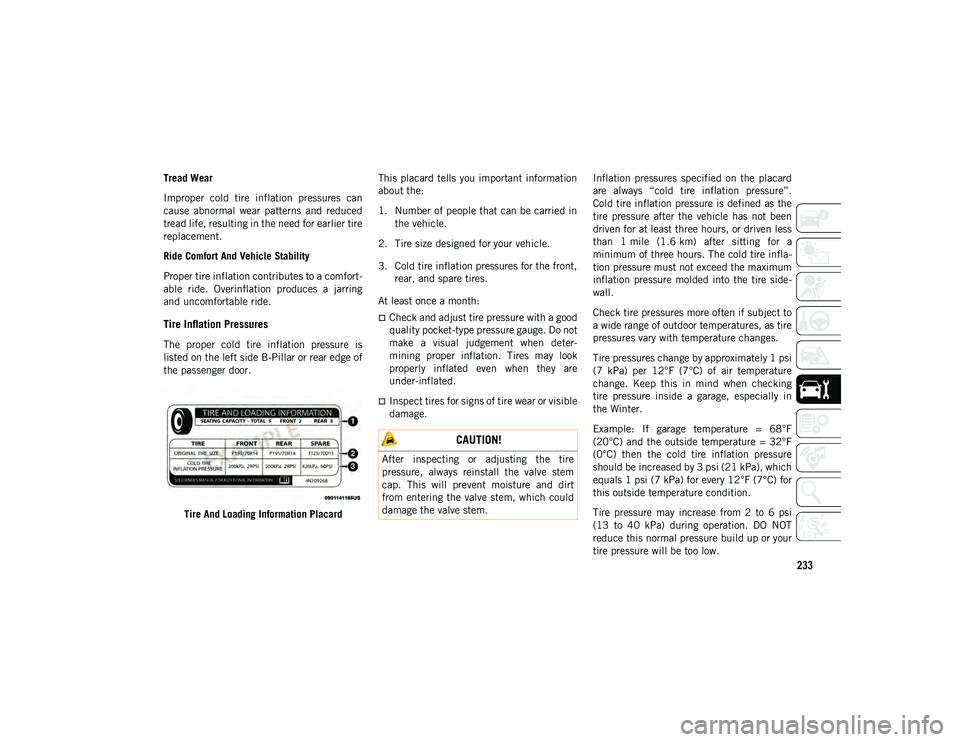
233
Tread Wear
Improper cold tire inflation pressures can
cause abnormal wear patterns and reduced
tread life, resulting in the need for earlier tire
replacement.
Ride Comfort And Vehicle Stability
Proper tire inflation contributes to a comfort-
able ride. Overinflation produces a jarring
and uncomfortable ride.
Tire Inflation Pressures
The proper cold tire inflation pressure is
listed on the left side B-Pillar or rear edge of
the passenger door.
Tire And Loading Information Placard This placard tells you important information
about the:
1. Number of people that can be carried in
the vehicle.
2. Tire size designed for your vehicle.
3. Cold tire inflation pressures for the front, rear, and spare tires.
At least once a month:
Check and adjust tire pressure with a good
quality pocket-type pressure gauge. Do not
make a visual judgement when deter -
mining proper inflation. Tires may look
properly inflated even when they are
under-inflated.
Inspect tires for signs of tire wear or visible
damage. Inflation pressures specified on the placard
are always “cold tire inflation pressure”.
Cold tire inflation pressure is defined as the
tire pressure after the vehicle has not been
driven for at least three hours, or driven less
than 1 mile (1.6 km) after sitting for a
minimum of three hours. The cold tire infla
-
tion pressure must not exceed the maximum
inflation pressure molded into the tire side -
wall.
Check tire pressures more often if subject to
a wide range of outdoor temperatures, as tire
pressures vary with temperature changes.
Tire pressures change by approximately 1 psi
(7 kPa) per 12°F (7°C) of air temperature
change. Keep this in mind when checking
tire pressure inside a garage, especially in
the Winter.
Example: If garage temperature = 68°F
(20°C) and the outside temperature = 32°F
(0°C) then the cold tire inflation pressure
should be increased by 3 psi (21 kPa), which
equals 1 psi (7 kPa) for every 12°F (7°C) for
this outside temperature condition.
Tire pressure may increase from 2 to 6 psi
(13 to 40 kPa) during operation. DO NOT
reduce this normal pressure build up or your
tire pressure will be too low.
CAUTION!
After inspecting or adjusting the tire
pressure, always reinstall the valve stem
cap. This will prevent moisture and dirt
from entering the valve stem, which could
damage the valve stem.
2020_JEEP_JL_WRANGLER_UG_RHD_UK.book Page 233
Page 241 of 330
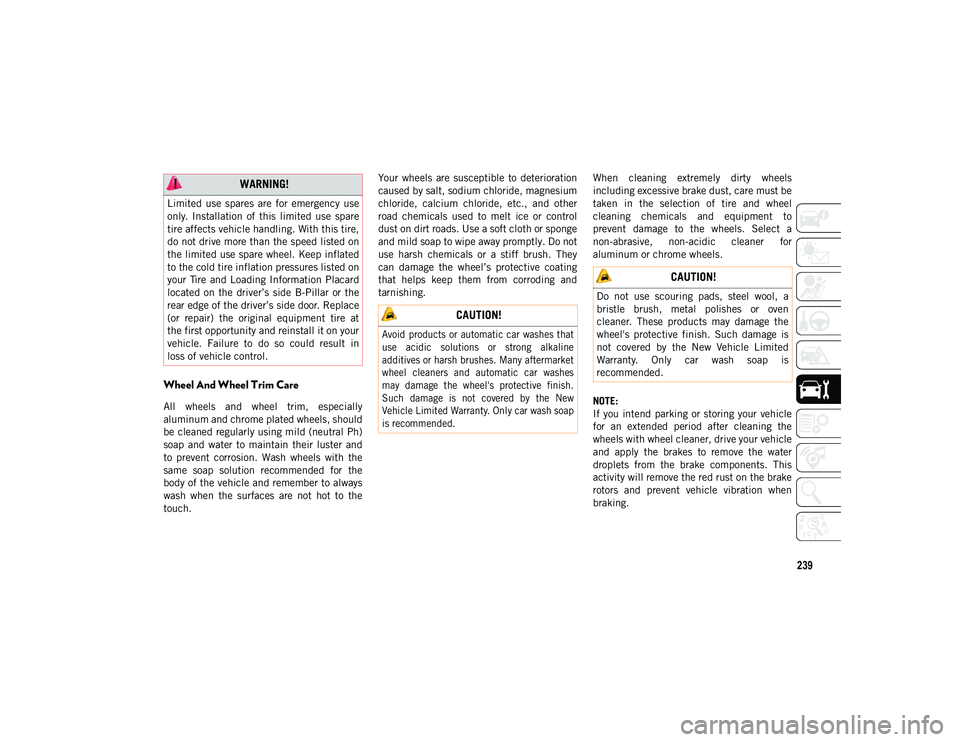
239
Wheel And Wheel Trim Care
All wheels and wheel trim, especially
aluminum and chrome plated wheels, should
be cleaned regularly using mild (neutral Ph)
soap and water to maintain their luster and
to prevent corrosion. Wash wheels with the
same soap solution recommended for the
body of the vehicle and remember to always
wash when the surfaces are not hot to the
touch.Your wheels are susceptible to deterioration
caused by salt, sodium chloride, magnesium
chloride, calcium chloride, etc., and other
road chemicals used to melt ice or control
dust on dirt roads. Use a soft cloth or sponge
and mild soap to wipe away promptly. Do not
use harsh chemicals or a stiff brush. They
can damage the wheel’s protective coating
that helps keep them from corroding and
tarnishing.
When cleaning extremely dirty wheels
including excessive brake dust, care must be
taken in the selection of tire and wheel
cleaning chemicals and equipment to
prevent damage to the wheels. Select a
non-abrasive, non-acidic cleaner for
aluminum or chrome wheels.
NOTE:
If you intend parking or storing your vehicle
for an extended period after cleaning the
wheels with wheel cleaner, drive your vehicle
and apply the brakes to remove the water
droplets from the brake components. This
activity will remove the red rust on the brake
rotors and prevent vehicle vibration when
braking.
WARNING!
Limited use spares are for emergency use
only. Installation of this limited use spare
tire affects vehicle handling. With this tire,
do not drive more than the speed listed on
the limited use spare wheel. Keep inflated
to the cold tire inflation pressures listed on
your Tire and Loading Information Placard
located on the driver’s side B-Pillar or the
rear edge of the driver’s side door. Replace
(or repair) the original equipment tire at
the first opportunity and reinstall it on your
vehicle. Failure to do so could result in
loss of vehicle control.
CAUTION!
Avoid products or automatic car washes that
use acidic solutions or strong alkaline
additives or harsh brushes. Many aftermarket
wheel cleaners and automatic car washes
may damage the wheel's protective finish.
Such damage is not covered by the New
Vehicle Limited Warranty. Only car wash soap
is recommended.
CAUTION!
Do not use scouring pads, steel wool, a
bristle brush, metal polishes or oven
cleaner. These products may damage the
wheel's protective finish. Such damage is
not covered by the New Vehicle Limited
Warranty. Only car wash soap is
recommended.
2020_JEEP_JL_WRANGLER_UG_RHD_UK.book Page 239
Page 242 of 330
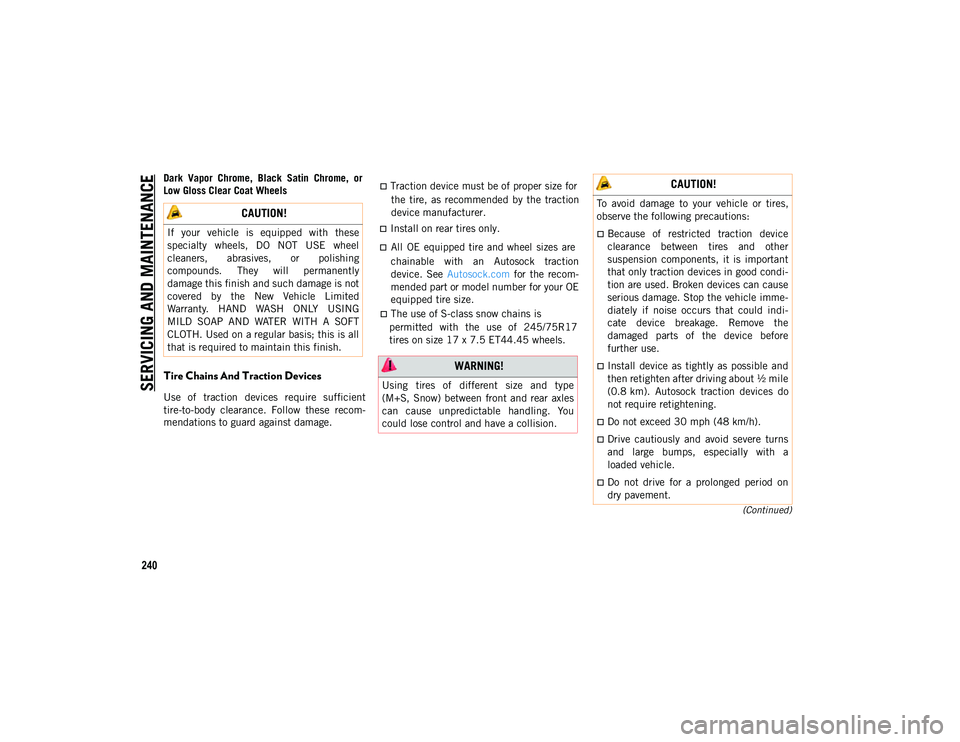
SERVICING AND MAINTENANCE
240
(Continued)
Dark Vapor Chrome, Black Satin Chrome, or
Low Gloss Clear Coat WheelsTire Chains And Traction Devices
Use of traction devices require sufficient
tire-to-body clearance. Follow these recom-
mendations to guard against damage.
the tire, as recommended by the traction
device manufacturer.
Install on rear tires only.
All OE equipped tire and wheel sizes are
chainable with an Autosock traction
device. See Autosock.com for the recom -
mended part or model number for your OE
equipped tire size.
permitted with the use of 245/75R17
tires on size 17 x 7.5 ET44.45 wheels.
CAUTION!
If your vehicle is equipped with these
specialty wheels, DO NOT USE wheel
cleaners, abrasives, or polishing
compounds. They will permanently
damage this finish and such damage is not
covered by the New Vehicle Limited
Warranty. HAND WASH ONLY USING
MILD SOAP AND WATER WITH A SOFT
CLOTH. Used on a regular basis; this is all
that is required to maintain this finish.
WARNING!
Using tires of different size and type
(M+S, Snow) between front and rear axles
can cause unpredictable handling. You
could lose control and have a collision.
CAUTION!
To avoid damage to your vehicle or tires,
observe the following precautions:
Because of restricted traction device
clearance between tires and other
suspension components, it is important
that only traction devices in good condi -
tion are used. Broken devices can cause
serious damage. Stop the vehicle imme-
diately if noise occurs that could indi -
cate device breakage. Remove the
damaged parts of the device before
further use.
Install device as tightly as possible and
then retighten after driving about ½ mile
(0.8 km). Autosock traction devices do
not require retightening.
Do not exceed 30 mph (48 km/h).
Drive cautiously and avoid severe turns
and large bumps, especially with a
loaded vehicle.
Do not drive for a prolonged period on
dry pavement.
2020_JEEP_JL_WRANGLER_UG_RHD_UK.book Page 240
The use of S-class snow chains is
Traction device must be of proper size for
Page 243 of 330

241
Tire Rotation Recommendations
The tires on the front and rear of your vehicle
operate at different loads and perform
different steering, handling, and braking
functions. For these reasons, they wear at
unequal rates.
These effects can be reduced by timely rota-
tion of tires. The benefits of rotation are
especially worthwhile with aggressive tread
designs such as those on On/Off Road type
tires. Rotation will increase tread life, help to
maintain mud, snow, and wet traction levels,
and contribute to a smooth, quiet ride. Refer to the “Maintenance Plan” for the
proper maintenance intervals. The reasons
for any rapid or unusual wear should be
corrected prior to rotation being performed.
The suggested rotation method is the “rear
-
ward-cross” shown in the following diagram.
Tire Rotation (Rearward Cross)
STORING THE VEHICLE
Observe the traction device manufacturer’s
instructions on the method of installation,
operating speed, and conditions for use.
Always use the suggested operating speed
of the device manufacturer’s if it is less
than 30 mph (48 km/h).
Do not use traction devices on a compact
spare tire.
CAUTION! (Continued)
CAUTION!
Proper operation of four-wheel drive
vehicles depends on tires of equal size,
type and circumference on each wheel.
Any difference in tire size can cause
damage to the transfer case. Tire rotation
schedule should be followed to balance
tire wear.
WARNING!
Take care to avoid the radiator cooling
fan whenever the hood is raised. It can
start anytime the ignition switch is ON.
You can be injured by moving fan blades.
Remove any metal jewelry such as rings,
watch bands and bracelets that could
make an inadvertent electrical contact.
You could be seriously injured.
Vehicles with the Stop/Start system will
be equipped with two batteries. Both the
main and the supplemental batteries
must be disconnected to completely
de-energize the 12 Volt electrical
system.
Serious injury or death could result if you
do not disconnect both batteries. To
learn how to properly disconnect, see
your authorized dealer.
2020_JEEP_JL_WRANGLER_UG_RHD_UK.book Page 241
Page 245 of 330
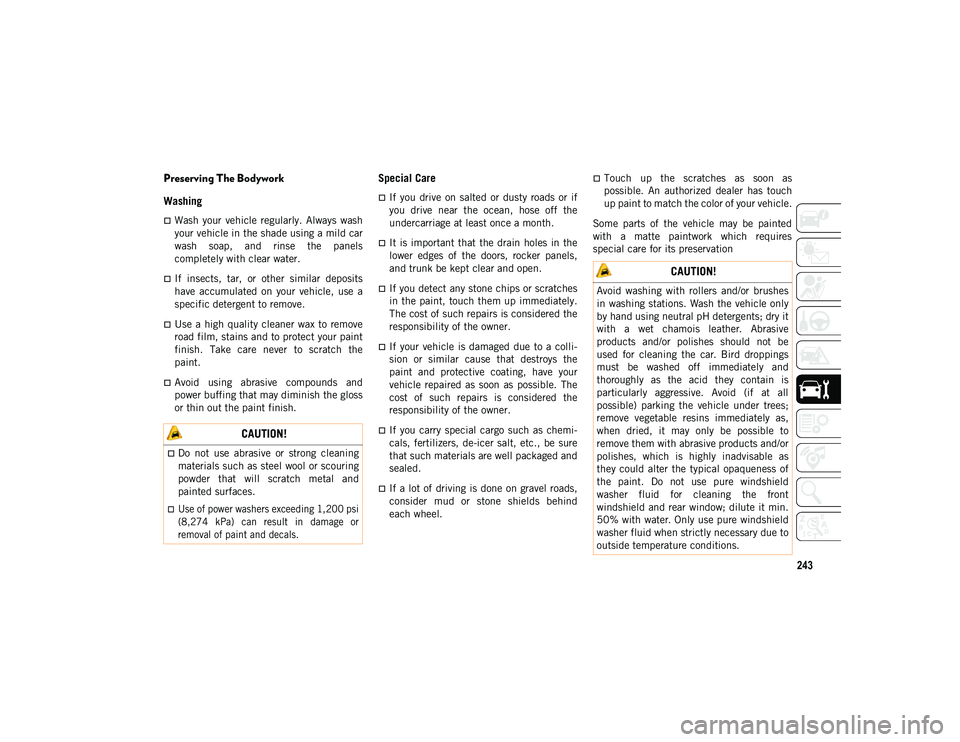
243
Preserving The Bodywork
Washing
Wash your vehicle regularly. Always wash
your vehicle in the shade using a mild car
wash soap, and rinse the panels
completely with clear water.
If insects, tar, or other similar deposits
have accumulated on your vehicle, use a
specific detergent to remove.
Use a high quality cleaner wax to remove
road film, stains and to protect your paint
finish. Take care never to scratch the
paint.
Avoid using abrasive compounds and
power buffing that may diminish the gloss
or thin out the paint finish.
Special Care
If you drive on salted or dusty roads or if
you drive near the ocean, hose off the
undercarriage at least once a month.
It is important that the drain holes in the
lower edges of the doors, rocker panels,
and trunk be kept clear and open.
If you detect any stone chips or scratches
in the paint, touch them up immediately.
The cost of such repairs is considered the
responsibility of the owner.
If your vehicle is damaged due to a colli-
sion or similar cause that destroys the
paint and protective coating, have your
vehicle repaired as soon as possible. The
cost of such repairs is considered the
responsibility of the owner.
If you carry special cargo such as chemi -
cals, fertilizers, de-icer salt, etc., be sure
that such materials are well packaged and
sealed.
If a lot of driving is done on gravel roads,
consider mud or stone shields behind
each wheel.
Touch up the scratches as soon as
possible. An authorized dealer has touch
up paint to match the color of your vehicle.
Some parts of the vehicle may be painted
with a matte paintwork which requires
special care for its preservation
CAUTION!
Do not use abrasive or strong cleaning
materials such as steel wool or scouring
powder that will scratch metal and
painted surfaces.
Use of power washers exceeding 1,200 psi
(8,274 kPa) can result in damage or
removal of paint and decals.
CAUTION!
Avoid washing with rollers and/or brushes
in washing stations. Wash the vehicle only
by hand using neutral pH detergents; dry it
with a wet chamois leather. Abrasive
products and/or polishes should not be
used for cleaning the car. Bird droppings
must be washed off immediately and
thoroughly as the acid they contain is
particularly aggressive. Avoid (if at all
possible) parking the vehicle under trees;
remove vegetable resins immediately as,
when dried, it may only be possible to
remove them with abrasive products and/or
polishes, which is highly inadvisable as
they could alter the typical opaqueness of
the paint. Do not use pure windshield
washer fluid for cleaning the front
windshield and rear window; dilute it min.
50% with water. Only use pure windshield
washer fluid when strictly necessary due to
outside temperature conditions.
2020_JEEP_JL_WRANGLER_UG_RHD_UK.book Page 243
Page 246 of 330
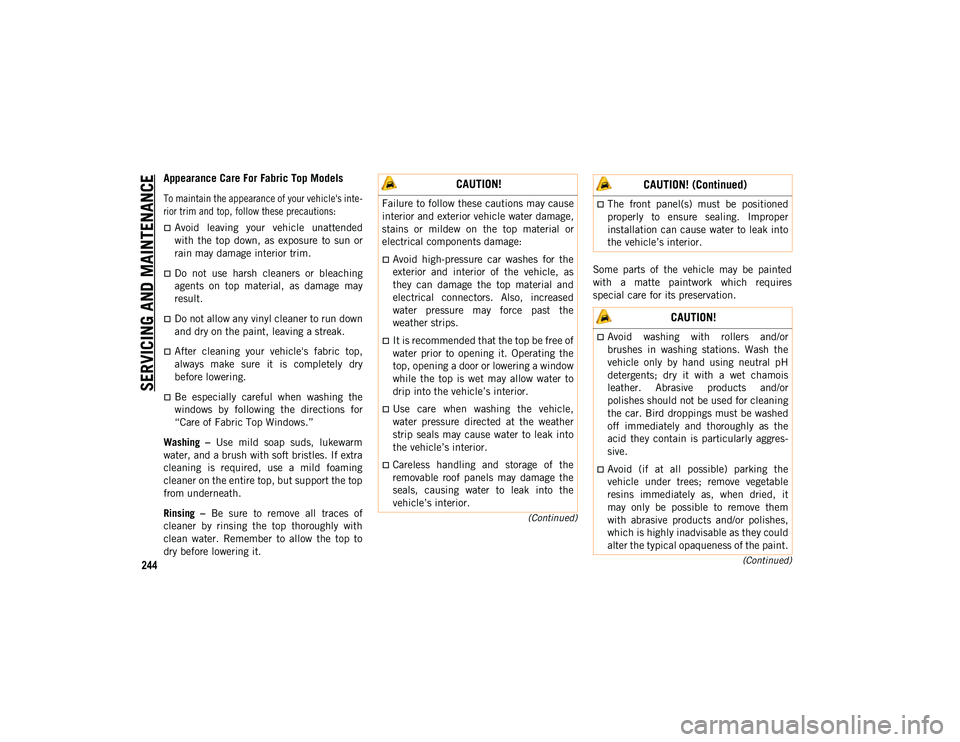
SERVICING AND MAINTENANCE
244(Continued)
(Continued)
Appearance Care For Fabric Top Models
To maintain the appearance of your vehicle's inte
-
rior trim and top, follow these precautions:
Avoid leaving your vehicle unattended
with the top down, as exposure to sun or
rain may damage interior trim.
Do not use harsh cleaners or bleaching
agents on top material, as damage may
result.
Do not allow any vinyl cleaner to run down
and dry on the paint, leaving a streak.
After cleaning your vehicle's fabric top,
always make sure it is completely dry
before lowering.
Be especially careful when washing the
windows by following the directions for
“Care of Fabric Top Windows.”
Washing – Use mild soap suds, lukewarm
water, and a brush with soft bristles. If extra
cleaning is required, use a mild foaming
cleaner on the entire top, but support the top
from underneath.
Rinsing – Be sure to remove all traces of
cleaner by rinsing the top thoroughly with
clean water. Remember to allow the top to
dry before lowering it. Some parts of the vehicle may be painted
with a matte paintwork which requires
special care for its preservation.
CAUTION!
Failure to follow these cautions may cause
interior and exterior vehicle water damage,
stains or mildew on the top material or
electrical components damage:
Avoid high-pressure car washes for the
exterior and interior of the vehicle, as
they can damage the top material and
electrical connectors. Also, increased
water pressure may force past the
weather strips.
It is recommended that the top be free of
water prior to opening it. Operating the
top, opening a door or lowering a window
while the top is wet may allow water to
drip into the vehicle’s interior.
Use care when washing the vehicle,
water pressure directed at the weather
strip seals may cause water to leak into
the vehicle’s interior.
Careless handling and storage of the
removable roof panels may damage the
seals, causing water to leak into the
vehicle’s interior.
The front panel(s) must be positioned
properly to ensure sealing. Improper
installation can cause water to leak into
the vehicle’s interior.
CAUTION!
Avoid washing with rollers and/or
brushes in washing stations. Wash the
vehicle only by hand using neutral pH
detergents; dry it with a wet chamois
leather. Abrasive products and/or
polishes should not be used for cleaning
the car. Bird droppings must be washed
off immediately and thoroughly as the
acid they contain is particularly aggres-
sive.
Avoid (if at all possible) parking the
vehicle under trees; remove vegetable
resins immediately as, when dried, it
may only be possible to remove them
with abrasive products and/or polishes,
which is highly inadvisable as they could
alter the typical opaqueness of the paint.
CAUTION! (Continued)
2020_JEEP_JL_WRANGLER_UG_RHD_UK.book Page 244
Page 247 of 330
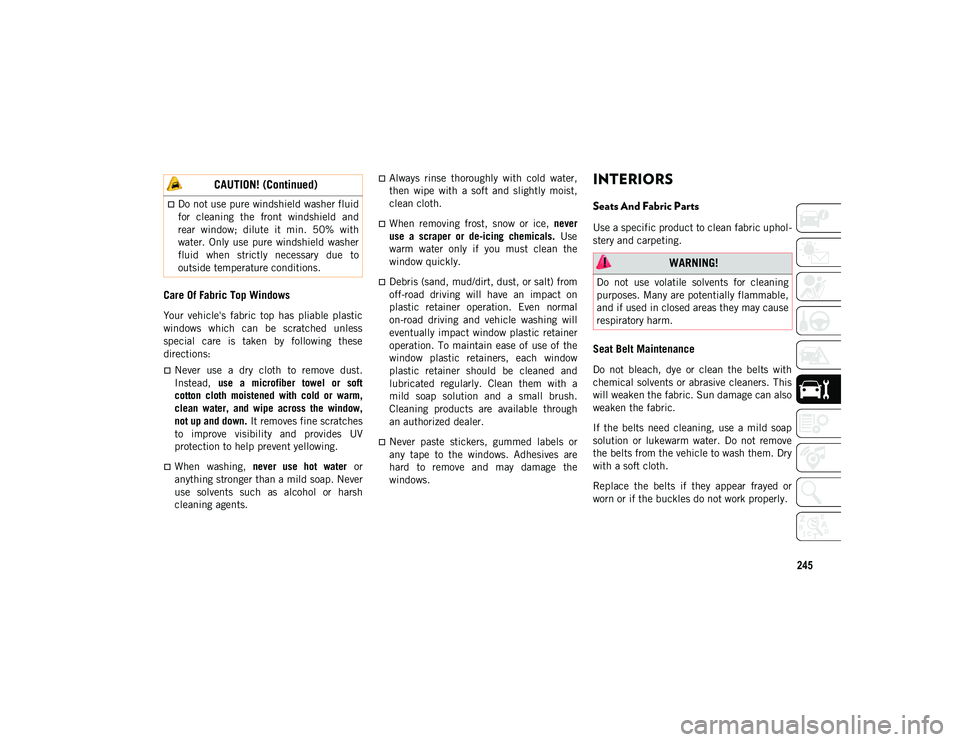
245
Care Of Fabric Top Windows
Your vehicle's fabric top has pliable plastic
windows which can be scratched unless
special care is taken by following these
directions:
Never use a dry cloth to remove dust.
Instead, use a microfiber towel or soft
cotton cloth moistened with cold or warm,
clean water, and wipe across the window,
not up and down. It removes fine scratches
to improve visibility and provides UV
protection to help prevent yellowing.
When washing, never use hot water or
anything stronger than a mild soap. Never
use solvents such as alcohol or harsh
cleaning agents.
Always rinse thoroughly with cold water,
then wipe with a soft and slightly moist,
clean cloth.
When removing frost, snow or ice, never
use a scraper or de-icing chemicals. Use
warm water only if you must clean the
window quickly.
Debris (sand, mud/dirt, dust, or salt) from
off-road driving will have an impact on
plastic retainer operation. Even normal
on-road driving and vehicle washing will
eventually impact window plastic retainer
operation. To maintain ease of use of the
window plastic retainers, each window
plastic retainer should be cleaned and
lubricated regularly. Clean them with a
mild soap solution and a small brush.
Cleaning products are available through
an authorized dealer.
Never paste stickers, gummed labels or
any tape to the windows. Adhesives are
hard to remove and may damage the
windows.
INTERIORS
Seats And Fabric Parts
Use a specific product to clean fabric uphol -
stery and carpeting.
Seat Belt Maintenance
Do not bleach, dye or clean the belts with
chemical solvents or abrasive cleaners. This
will weaken the fabric. Sun damage can also
weaken the fabric.
If the belts need cleaning, use a mild soap
solution or lukewarm water. Do not remove
the belts from the vehicle to wash them. Dry
with a soft cloth.
Replace the belts if they appear frayed or
worn or if the buckles do not work properly.
Do not use pure windshield washer fluid
for cleaning the front windshield and
rear window; dilute it min. 50% with
water. Only use pure windshield washer
fluid when strictly necessary due to
outside temperature conditions.
CAUTION! (Continued)
WARNING!
Do not use volatile solvents for cleaning
purposes. Many are potentially flammable,
and if used in closed areas they may cause
respiratory harm.
2020_JEEP_JL_WRANGLER_UG_RHD_UK.book Page 245
Page 258 of 330
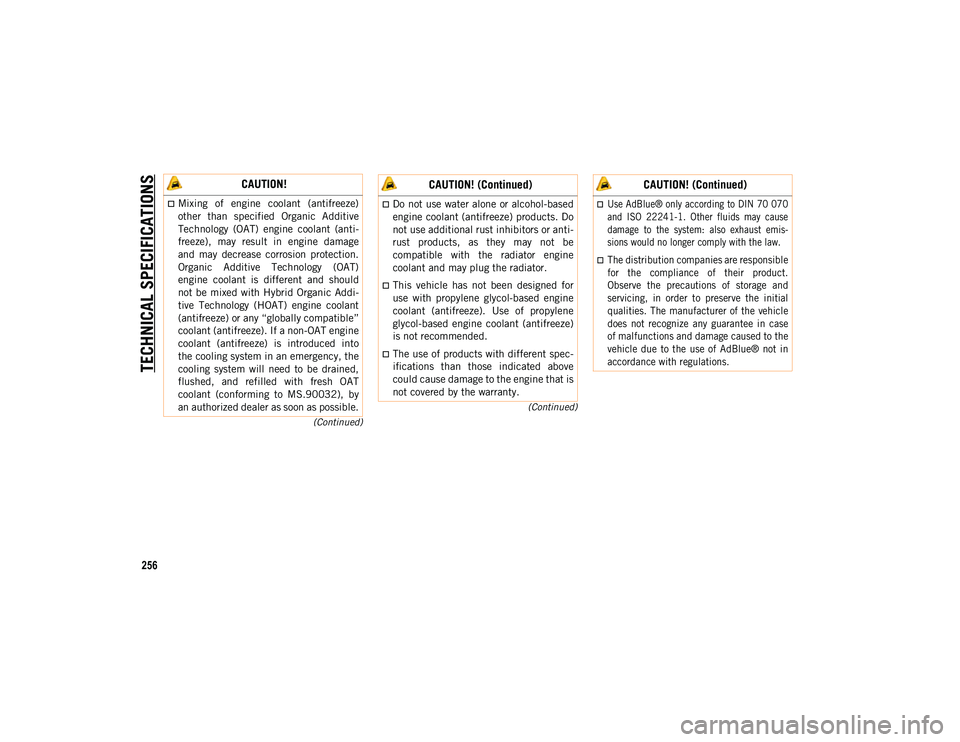
TECHNICAL SPECIFICATIONS
256
(Continued)
(Continued)
CAUTION!
Mixing of engine coolant (antifreeze)
other than specified Organic Additive
Technology (OAT) engine coolant (anti -
freeze), may result in engine damage
and may decrease corrosion protection.
Organic Additive Technology (OAT)
engine coolant is different and should
not be mixed with Hybrid Organic Addi -
tive Technology (HOAT) engine coolant
(antifreeze) or any “globally compatible”
coolant (antifreeze). If a non-OAT engine
coolant (antifreeze) is introduced into
the cooling system in an emergency, the
cooling system will need to be drained,
flushed, and refilled with fresh OAT
coolant (conforming to MS.90032), by
an authorized dealer as soon as possible.Do not use water alone or alcohol-based
engine coolant (antifreeze) products. Do
not use additional rust inhibitors or anti -
rust products, as they may not be
compatible with the radiator engine
coolant and may plug the radiator.
This vehicle has not been designed for
use with propylene glycol-based engine
coolant (antifreeze). Use of propylene
glycol-based engine coolant (antifreeze)
is not recommended.
The use of products with different spec-
ifications than those indicated above
could cause damage to the engine that is
not covered by the warranty.
CAUTION! (Continued)
Use AdBlue® only according to DIN 70 070
and ISO 22241-1. Other fluids may cause
damage to the system: also exhaust emis -
sions would no longer comply with the law.
The distribution companies are responsible
for the compliance of their product.
Observe the precautions of storage and
servicing, in order to preserve the initial
qualities. The manufacturer of the vehicle
does not recognize any guarantee in case
of malfunctions and damage caused to the
vehicle due to the use of AdBlue® not in
accordance with regulations.
CAUTION! (Continued)
2020_JEEP_JL_WRANGLER_UG_RHD_UK.book Page 256